Bromeliad: plant care, propagation & facts
Bromeliad plants have become increasingly popular for adding a tropical burst of colour to the home. Below is all you need to know about this beautiful plant and how to care for it in your home.
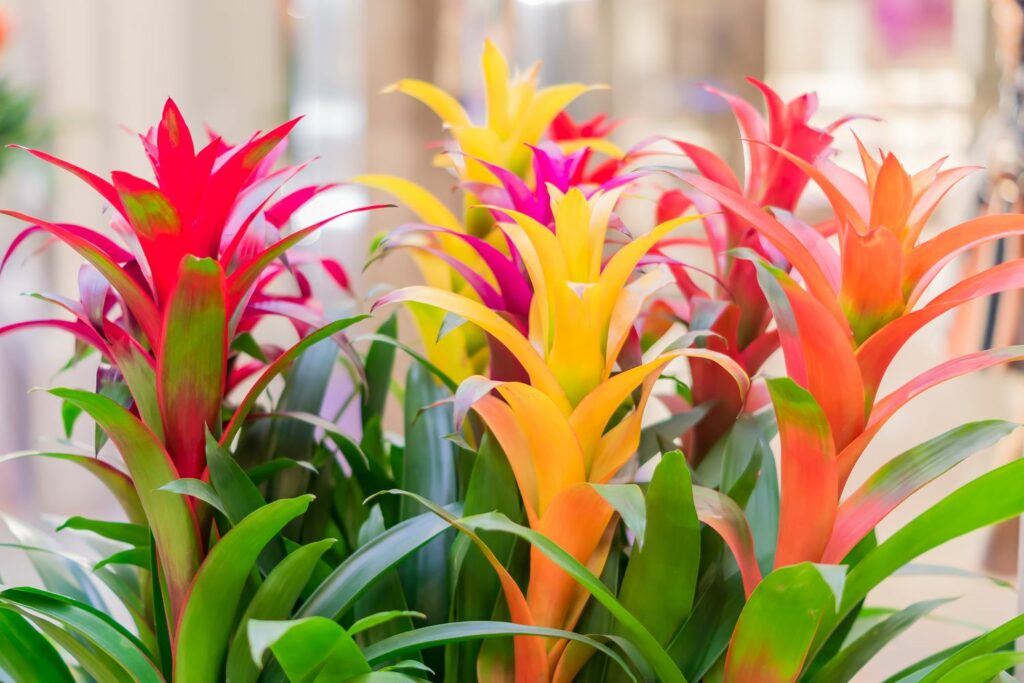
The bromeliad family (Bromeliaceae) includes many species that come in many shapes and colours. Here are some of the most beautiful bromeliad varieties and how to properly take care of them.
Contents
- Bromeliads: flower, origin, and other characteristics
- The most beautiful bromeliad varieties
- Planting Bromeliads: when, where, and how
- Bromeliad care
- Getting bromeliads to bloom
- Bromeliad care after they have bloomed
- Repotting bromeliads
- Supporting bromeliads
- Are bromeliads hardy?
- Propagating bromeliads
- Are bromeliads poisonous?
Bromeliads: flower, origin, and other characteristics
The bromeliad plant family (Bromeliaceae) contains up to 2100 different species. Bromeliads are evergreen, herbaceous, and perennial plants. Most can be found in the rainforests of South and Central America, growing on the forest floor or climbing on trees, where they can better reach sunlight, although some bromeliads prefer higher more mountainous regions.
Bromeliads usually have a rosette-shaped flower and funnel-shaped leaves designed to catch water. These uniquely shaped leaves can also catch dead leaves or bird droppings, which provide nutrients for the bromeliad plant.

Bromeliads even provide habitat for other water plants and frogs in their leaf funnel. Using their roots, the bromeliads find a foothold either in the ground or on branches without harming the trees. The bromeliad’s brightly coloured leaves really make the plant stand out, while its spike-shaped flower is rather more subtle. Of all the bromeliad varieties, the pineapple plant is probably the most well-known, which is why the bromeliad family is often referred to as the “pineapple family”.
Tip: With a little luck, you can grow a plant from a pineapple. Just cut the green stalk from the fruit, let it dry for a day and plant it in a pot with soil.

The most beautiful bromeliad varieties
There are numerous bromeliad genera, species, and varieties, each with unique characteristics, but only some of them can be kept as indoor plants. Here is our list of the best indoor bromeliad varieties.
- Genus Guzmania: This genus is particularly popular as a houseplant. There are several Guzmania varieties that range from bright red to yellow to purple or white; some even have bi-colored leaves. In the wild, guzmania grows epiphytically, so as a non-parasitic plant perched on trees.
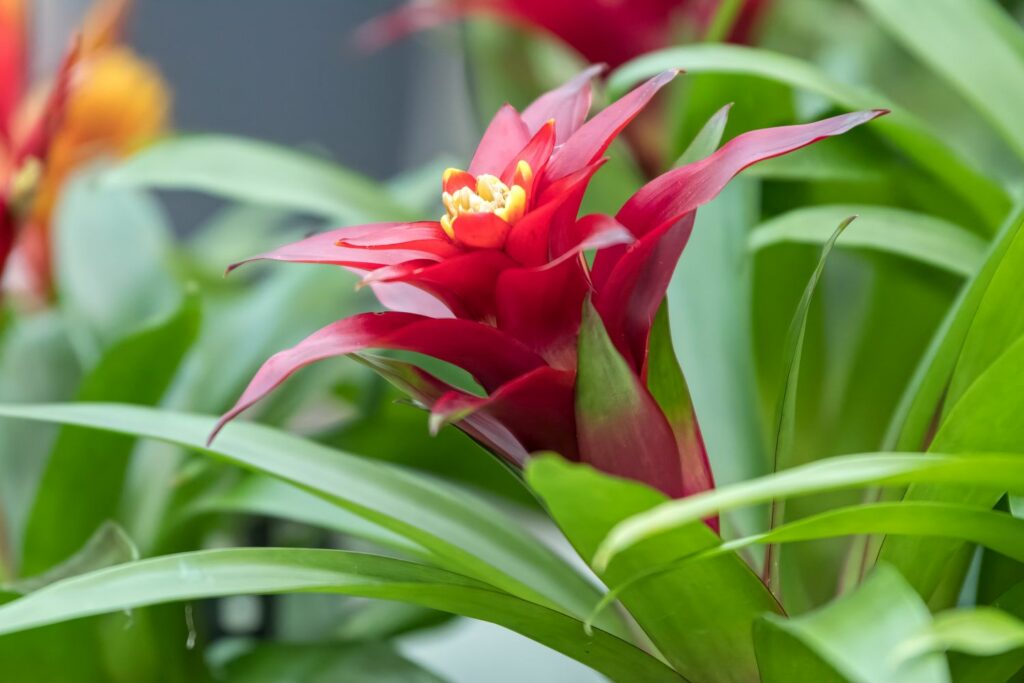
- Genus Aechmea: This genus comes not only in a variety of colours, but also with uniquely patterned leaves. Because of the shape of its leaves, aechmea is sometimes referred to as the lance rosette. Like guzmania, aechmea is also an epiphytic bromeliad, which means they grow perched on trees.

- Genus Vriesea: This bromeliad is often referred to as “flaming sword” because of its dramatic leaves and lance-shaped flower. Like most bromeliads, Vriesea comes in many colours.

- Genus Pineapple: This is the most well-known bromeliad species, but not everyone knows that pineapple can also be grown as a houseplant. Under the right conditions, this variety can of course produce fruit. As an indoor plant, however, they remain quite small and are more for decoration than for consumption. Pineapple plants are one of the terrestrial bromeliads, meaning they simply grow in a bush-like form on the ground.
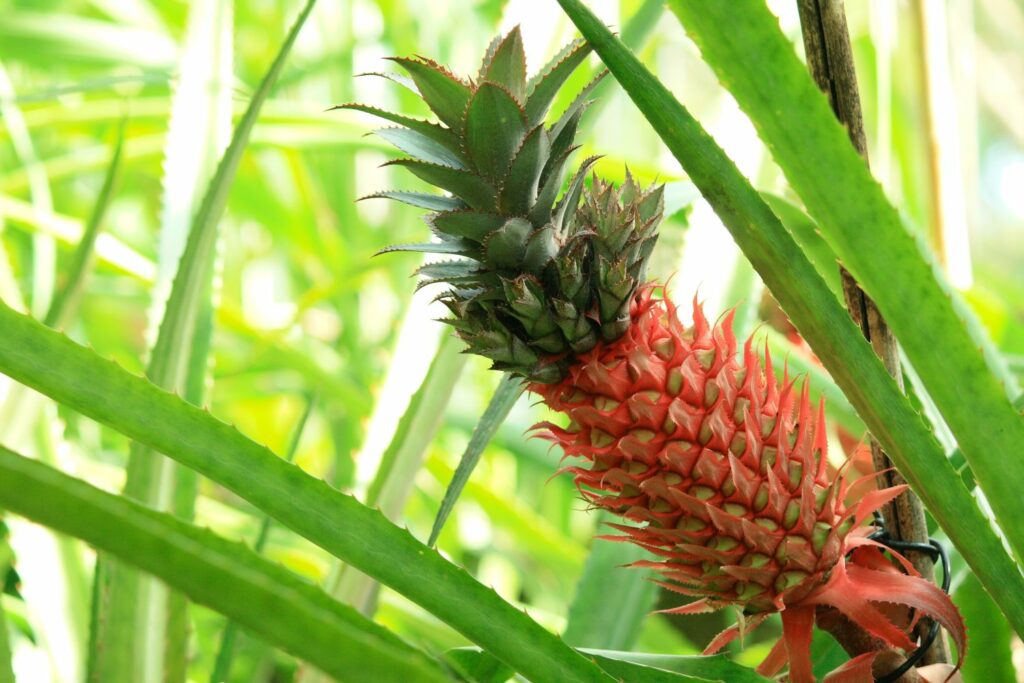
- Genus Tillandsia: Within this genus, there are grey and green varieties. Grey tillandisias are found in dry areas, growing epiphytically on trees, whereas green tillandisias grow on the ground in more humid locations. Tillandsia leaves are usually narrow and pointed, while its bracts come in different colours.
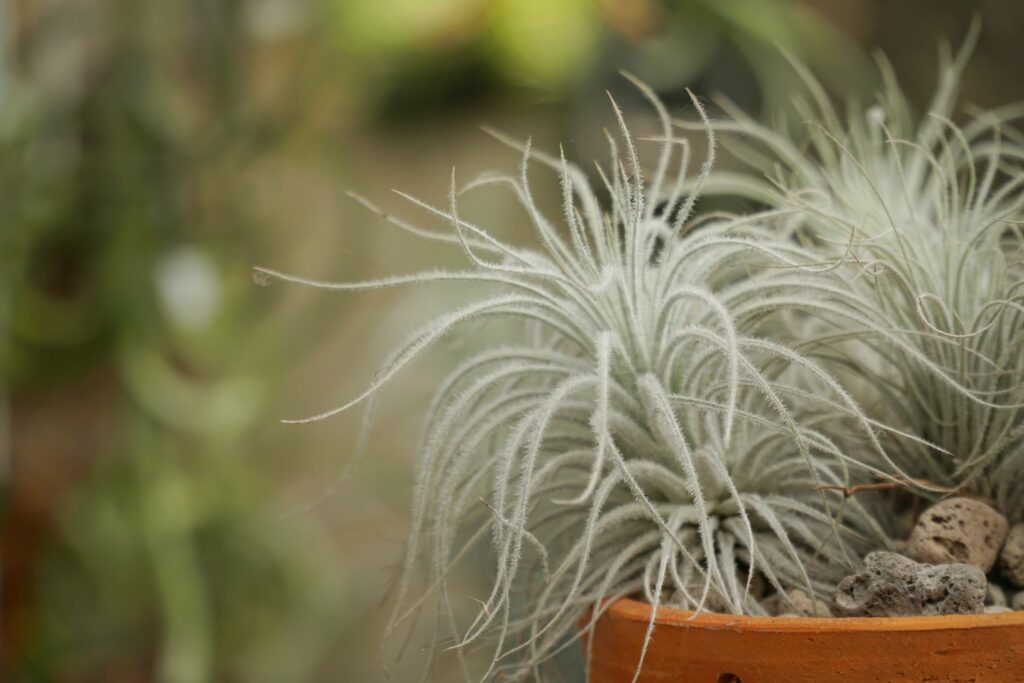
Planting Bromeliads: when, where, and how
Though sold as houseplants, bromeliads are still tropical plants that crave a humid and warm climate. To grow a healthy bromeliad indoors, you need to keep the plant in a warm, bright, and humid location.
The right location
A bright place out of midday direct sunlight is perfect for the bromeliad. Weaker morning and evening sun is good for the plant and can stimulate flower growth. Some varieties, however, like the grey tillandsias, prefer a location with direct and consistent sunlight. Keep the room temperature around 20°C or more throughout the day and always above 18°C. High humidity is also key for bromeliad health, so bright bathrooms are the ideal location for these tropical plants. With enough misting from a bottle or a humidifier, bromeliads can also thrive in any sunny room. Alternatively, you can place a bowl with water on a nearby heater to help increase humidity around the plant.
Tip: In an area with warm to hot summers, it is possible to keep your bromeliad outside. But do not leave the plant outside in temperatures cooler than 15°C, especially at night. Make sure to bring your bromeliad inside on cooler evenings!

The right soil
Depending on whether the plants grow epiphytically or terrestrially, bromeliads need different soils. Here is a guide to each type’s needs.
Epiphytic bromeliads form very few roots and absolutely need an airy soil that gives them support but that does not retain water. For example, a mixture of one part dried peat moss and two parts bark is perfect for epiphytic bromeliads. Some bromeliads can even be grown in stones and pebbles.
Other bromeliads grow well in terrariums. To do this, cover the bromeliad at the roots with moss to improve the supply of water. Then tie the whole plant to a branch in the terrarium with wire or fishing line and keep it nice and moist. If there are holes or crevices in the branch, you can of course place the bromeliad in them. After about four weeks, roots should form. When these are long enough for the bromeliad to hold onto the branch itself, remove the wire.
Tip: Whatever planting method you use, give your bromeliad a generous spray of water once it has been planted.
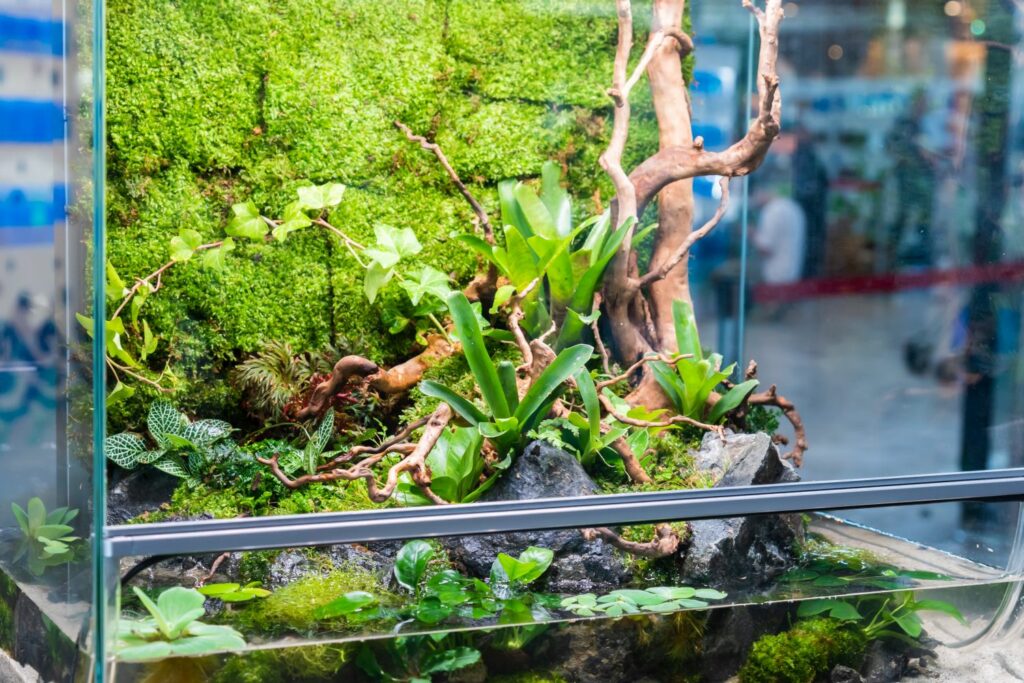
Terrestrial bromeliads need permeable and slightly acidic soil. Ericaceous compost with a pH balance between 4.6 – 5.4 works best. Mix this soil with sand and pine bark (around 7 – 15 mm) in a ratio of 2:1:2 to provide the optimal permeability and acidity for your plant.
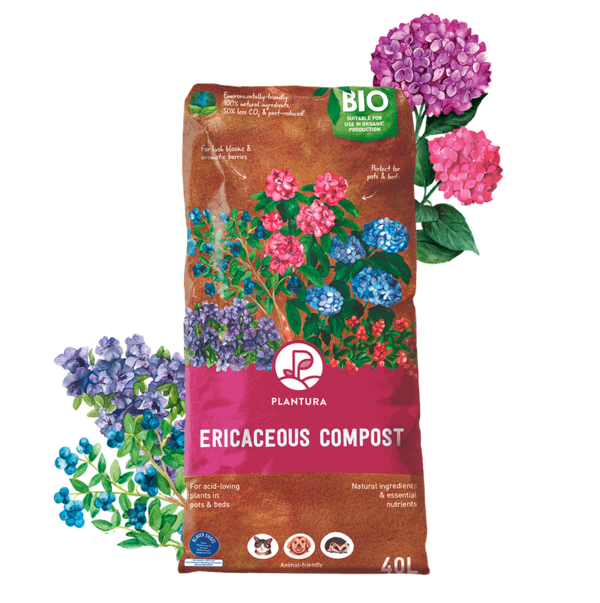
- Perfect for acid-loving plants such as hydrangeas, rhododendrons, blueberry bushes, azaleas & more
- Ensures all-round healthy plants with lush blooms and aromatic berries
- Peat-reduced & organic soil: CO2-saving composition
Bromeliad care
When it comes to bromeliad care, watering is key. You need to consider not only how and when your plant is getting water, but other factors like humidity and types of water too.
Watering, fertilising and pruning bromeliads
Watering: In the rainforests, bromeliads collect rainwater with their funnel-shaped leaves. So, when kept as a houseplant, bromeliads need low-lime, room-temperature water, ideally rainwater.
Bromeliad’s watering needs vary depending on the species and location. As a rule of thumb, water terrestrial bromeliads about once a month by pouring water directly into their funnel-like leaves. Of course, you should water more frequently in the summer than in the winter. Also make sure to always keep the soil moist.
Epiphytic bromeliads, that grow without any soil, need to be sprayed with water regularly. In the summer, spray your plant daily, and in the winter less frequently, about once a week.

Fertilising: Liquid fertilisers, such as our Plantura Liquid Houseplant Food, are best suited to bromeliads and can easily be incorporated into any watering plan. Since bromeliads do not have high nutrient requirements, fertilise with half the recommended dose. During the summer, apply fertiliser roughly every two weeks. Tillandsias and other tied up bromeliads require fewer nutrients. Here, fertilising every four weeks with a dosage of around 25% is enough.

- Perfect for a wide variety of houseplants & foliage plants
- Liquid fertiliser for robust plants & healthy growth
- Quick & easy application - child & pet friendly
Pruning: Bromeliads do not require pruning. Even withered leaves are best left to fall off and further fertilise the soil.

Getting bromeliads to bloom
There is a simple trick to make bromeliads bloom: Flowering is stimulated by the gas ethylene, which is also emitted by ripening fruit. Here is how to use ripening fruits to help bromeliads bloom:
- Put an apple or banana in or next to the bromeliad pot
- Place the bromeliad and fruit in the brightest and warmest location possible
- Cover the whole plant with glass or a plastic bag to help speed up the process
- After about three weeks, the fruit and covering can be removed
- Care for the plant as before, with plenty of water, humidity, and an occasional dose of fertiliser
- After about eight weeks, the bromeliad plant should begin to bloom

Bromeliad care after they have bloomed
Once your bromeliad has bloomed and withered, there is no reason to throw the plant away. Bromeliads will produce offshoots plants, called pups, at the base of the plant as it flowers. To cultivate these offshoots, continue watering and fertilising the mother plant as you normally would until the pups are large enough to stand in their own pot.
Here are some tips on how to re-pot young bromeliad pups!
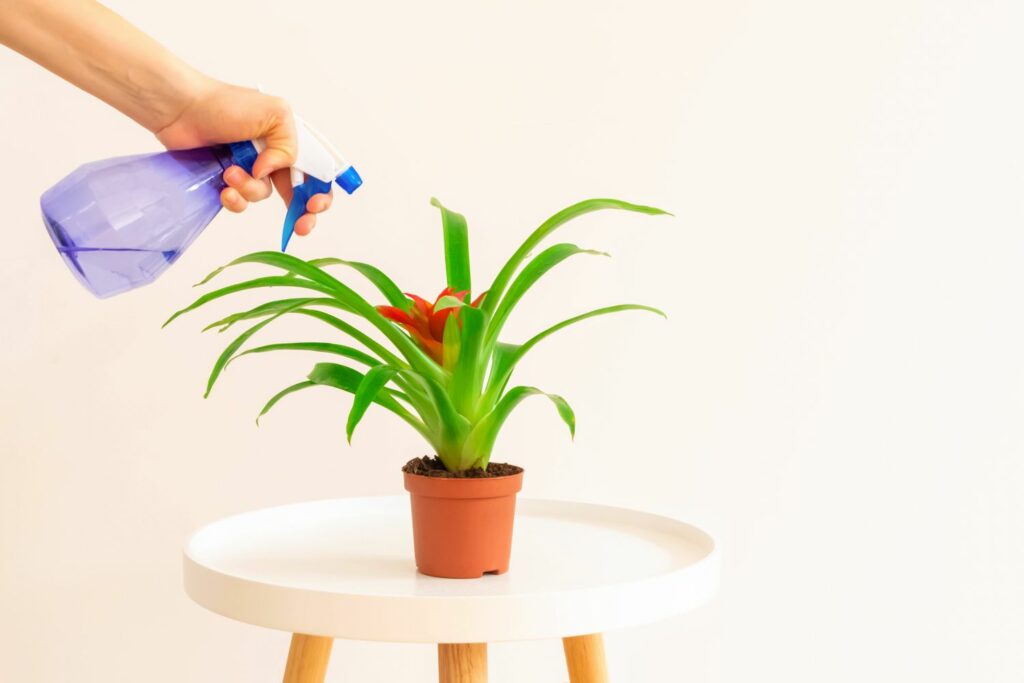
Repotting bromeliads
Once your bromeliads begin to run out of room to grow, it’s time to re-pot! This is best done in the spring, just before the growing season begins. To re-pot, simply choose a larger container and fill it with a layer of broken clay and then a layer of soil. Plant your bromeliad in the planting hole, and lightly press the surrounding soil. Bromeliads should be repotted immediately after purchase, as the soil they are often sold in is not suitable for the long term.
Supporting bromeliads
If you have chosen an epiphytic bromeliad, the plant does not necessarily need to be planted. As mentioned above, it is possible to tie them onto a branch in a terrarium. Here are more specific instructions on how to do so:
- Cover the base of the bromeliad with moss
- Secure the whole thing with wire or fishing line
- Place the bromeliad in the branch’s crevice, or simply tie the plant to the branch with the wire
- Moisten the moss sufficiently and care for the epiphytic bromeliad as usual
- Once roots begin to form, remove the moss and allow the bromeliad to hang by itself on the branch

Are bromeliads hardy?
Bromeliads are tropical plants by nature and do not tolerate the cold. In the winter, they need temperatures of at least 14°C to survive. Between October and March, bromeliads go through a dormant phase. This essentially means that they grow only slightly or not at all. In their dormant phase, bromeliads need less water and fertiliser.
Propagating bromeliads
Bromeliad offshoots
There is a very simple method to propagate bromeliads. After flowering, bromeliads form offshoots, called pups, which can be easily used to propagate the plant. Until the offshoots reach a size of about 10 cm, simply continue to care for the mother plant as usual. When the offshoots are large enough, they can be cut from the mother bromeliad. Then plant the bromeliad pups in separate pots with suitable soil and place them in a bright and warm spot. To give the young plants optimal humid conditions, cover them with glass or a plastic bag. Begin watering and fertilising your new bromeliad just as with adult plants. If the bromeliad pup forms new leaves, the propagation has been successful and you can remove the cover.

Propagation from seed
Propagation by seed is not always successful with bromeliads. The seeds need constant temperatures around 25°C and a bright place to germinate. The seeds are light germinators, so do not cover them with soil. Instead, spread the seeds on a substrate, such as a mixture of sphagnum moss and vermiculite, which is well moistened and press down lightly. Now cover the whole thing with cling film to increase the humidity. Germination should start after about 14 days. However, do continue to cover the plants with cling film until a few leaves have formed. The small plants can then be gradually hardened off by acclimatising them to lower humidity before finally repotting. To do this, remove the cling film for a few hours at a time in the beginning. Gradually increase the phases without cover until the seedlings have finally become accustomed to the lower humidity in the room.
Are bromeliads poisonous?
With the exception of unripe pineapple fruits, bromeliads are not poisonous. Only the pointed leaves can pose a small danger to children and pets.
Most orchids also grow epiphytically and are propagated by offshoots, known as “keiki”. Watch our video tutorial to learn how to propagate orchids from offshoots.



















